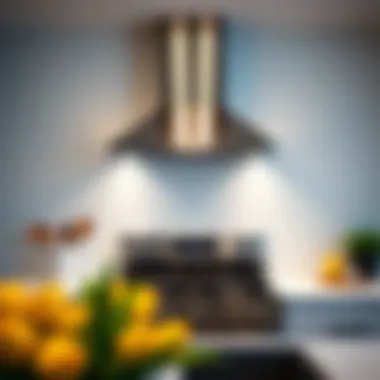Exploring Built-in Exhaust Systems for Stoves


Intro
In the culinary world, a kitchen isn't just a place to whip up meals; it's a hub of activity and flavor. One crucial element often overlooked in kitchen planning is the built-in exhaust system for stoves. These systems are essential not only for keeping the air fresh but also for maintaining an inviting atmosphere while cooking.
Proper ventilation can drastically improve air quality, reducing smoke, steam, and cooking odors that tend to linger long after the dish is prepared. An exhaust system can mean the difference between a pleasant cooking experience and a kitchen that feels like a pressure cooker—literally.
In this comprehensive overview, we will cover the various designs, types, and installation challenges associated with built-in exhaust systems. We will also highlight their advantages in both residential and commercial kitchens and discuss how they can enhance functionality and safety.
By the end of this read, homeowners, designers, and DIY enthusiasts alike should have a firm grasp of how these systems work and what to consider when selecting the right one for their kitchens.
Importance of Excellent Ventilation
Good ventilation serves more than just aesthetics. Imagine frying bacon: the aroma—while delightful—can become overwhelming if not managed properly. An efficient exhaust system draws out excess smoke and odors, ensuring that your kitchen remains a pleasant place to gather.
"A good exhaust system is not just about function; it also elevates the ambiance of your kitchen."
Moreover, a well-ventilated kitchen minimizes the risk of grease buildup, which can lead to dangerous fire hazards. Building codes in many areas now require ventilations systems in new kitchens, further underscoring their importance with regard to safety standards.
The Role of Exhaust Systems in Kitchen Design
When designing a kitchen, exhaust systems should not be an afterthought. Placing an effective exhaust system in relation to the stove can mean the difference between cooking bliss and culinary chaos.
Types of Built-in Exhaust Systems
There's no one-size-fits-all when it comes to exhaust systems. Homeowners might find themselves choosing between the following:
- Under-Cabinet Hoods: These compact units fit snugly under kitchen cabinets and offer a straightforward solution without taking up too much space.
- Wall-Mounted Hoods: A perfect option for those who have an open kitchen layout. These hoods can even act as a statement piece in the room.
- Island Hoods: Ideal for kitchen islands, this type of hood hovers above the stove and draws attention while ensuring that the air quality remains unpolluted.
- Downdraft Systems: For more modern designs, a downdraft system retracts when not in use, offering a sleek look without sacrificing performance.
Choosing the right type will depend on the layout and aesthetic preferences, but it’s crucial to ensure that the chosen system effectively addresses cooking fumes.
Installation Processes and Challenges
While installation might appear straightforward, several factors come into play that can complicate the process. Key challenges include:
- Ducting: Proper duct installation is crucial for optimal performance. Poorly installed ducts can cause inefficiencies.
- Placement: Achieving the right height can enhance performance. Too high and it may not capture fumes effectively; too low can obstruct cooking space.
- Compatibility with Kitchen Design: The exhaust must not only be functional but should also complement the kitchen's design.
Prospective installers should consult with professionals to navigate these challenges and ensure the exhaust system works as intended.
Synthesis of Information
To wrap it all up, a built-in exhaust system is a necessary investment for any kitchen. When chosen and installed correctly, it enhances air quality, safety, and overall kitchen enjoyment. As you weigh your options, consider both functionality and design aspects for a balanced decision. Whether you’re a homeowner dreaming of the perfect kitchen or a designer looking for efficient solutions, understanding these systems will go a long way in creating a culinary haven.
For further exploration of regulatory guidelines and advanced system critiques, consider visiting EPA.gov or ASID.org. These platforms offer a wealth of resources and insights that can aid in your journey to achieve better kitchen ventilation.
Prolusion to Built-in Exhaust Systems
When it comes to creating a functional kitchen environment, one area that often gets overlooked is the ventilation system. Built-in exhaust systems for stoves are not just a luxury; they play a critical role in ensuring the efficiency and safety of your culinary space. Understanding the ins and outs of these systems can significantly enhance the quality of air in your kitchen, contributing to a healthier and more pleasant cooking experience.
Understanding the Basics
At its core, a built-in exhaust system serves the fundamental purpose of removing smoke, odors, and airborne particulates generated during cooking. These systems are designed to encourage proper air circulation, which can help keep your kitchen area cool while eliminating various pollutants. Unlike traditional standalone exhaust fans, built-in options can reduce the visual clutter in your kitchen by integrating seamlessly into cabinetry or the stove itself.
Key Features to Consider:
- Design Flexibility: Some models can be concealed when not in use, providing a cleaner aesthetic.
- Efficiency: Built-in systems often operate at higher efficiency levels because they are designed to fit specific spaces.
- Noise Levels: The sound output from the exhaust system can vary, so it's wise to factor this into your decision.
By diving into how these systems function, one can start to appreciate their role not only in improving air quality but also in creating a more inviting space for cooking.
The Importance of Kitchen Ventilation
Effective kitchen ventilation is much more than a good idea; it’s a necessity. Poor air quality can lead to health issues, such as respiratory problems or allergies, compounded by unpleasant cooking odors wafting through the living area. A built-in exhaust system is essential in mitigating these issues.
"A well-ventilated kitchen is a happy kitchen."
The benefits of proper ventilation cannot be overstated:
- Healthier Environment: Reduces harmful smoke and chemical residues from food preparation.
- Comfort: Regulates heat and humidity levels, making cooking a less uncomfortable chore.
- Longevity of Appliances: Helps to minimize grease and other substances that can accumulate and damage kitchen appliances over time.
Taking the time to invest in a quality built-in exhaust system can transform your kitchen experience, making it more functional and enjoyable for everyone involved. As we move forward in this comprehensive overview, we aim to explore the various systems available and the unique benefits each provides, ensuring that you make an informed decision for your culinary environment.
Types of Built-in Exhaust Systems
When it comes to kitchen ventilation, understanding the various types of built-in exhaust systems is essential. Each system offers distinct advantages, suited to different kitchen designs and cooking styles. By knowing what options are available, homeowners and designers can make informed choices that improve air quality, reduce smoke, and enhance kitchen aesthetics.


Downdraft Vents
Downdraft vents provide a unique solution for those looking to maximize space while maintaining effective ventilation. These sleek, integrated systems sit flush with your stovetop, rising only when needed. They are especially valuable in open-concept layouts where traditional hoods would obstruct sightlines.
The primary benefit of downdraft vents is their ability to minimize visual clutter. With their low profile, they streamline the kitchen's look without sacrificing functionality. However, it's important to consider their power; while they are effective for light cooking tasks, they might not perform as well with heavy frying and grilling compared to other systems.
Range Hoods
Range hoods come in various styles, each tailored for specific kitchen setups and aesthetic preferences. They play a crucial role in capturing smoke, steam, and odors effectively.
Wall-mounted
Wall-mounted range hoods act as a statement piece, combining functionality with style. Installed directly above the stove, these units are designed to hover prominently, drawing attention and compliments. They're a popular choice among many homeowners due to their efficiency in exhausting air while also giving a sleek, modern touch to the kitchen.
One noteworthy feature is their powerful suction capabilities, ensuring that even the most pungent cooking aromas are swiftly removed. That said, their significant size may not be ideal for smaller kitchens where space is at a premium.
Under-cabinet
Under-cabinet range hoods fit snugly beneath kitchen cabinets, making them an excellent choice for those who want to maintain counter space. Their compact design helps save precious space while providing reliable ventilation.
One of their key characteristics is versatility; they come in various styles and sizes, accommodating different kitchen designs. However, the primary drawback is the potential for noise; many models can be quite loud, especially at higher settings. Still, for many, the functionality outweighs the noise concerns.
Island hoods
Island hoods are specifically designed for kitchens with a stovetop situated on an island. These hoods serve both a practical purpose and a design one, often becoming the focal point of the kitchen. One of the key characteristics of island hoods is their availability in a variety of styles, ranging from contemporary to classic. This diversity allows homeowners to choose a model that complements their overall kitchen decor.
Despite their high effective suction capabilities, island hoods might require more ductwork and installation planning, which could complicate the setup compared to other types.
Ceiling-mounted Exhaust Fans
Ceiling-mounted exhaust fans offer a less traditional but highly effective way of ventilating kitchens. They are mounted directly into the ceiling and serve to pull air from the kitchen upwards, making them a great fit for modern designs with high ceilings.
These fans ensure that kitchen air is continuously circulated, helping to maintain freshness. Their unobtrusive design allows for greater design flexibility in the kitchen layout.
However, ceiling-mounted fans might not always catch all the cooking odors and smoke, since they don't hang over the stove like traditional hoods. It’s essential to consider cooking habits when deciding on this option.
Benefits of Built-in Exhaust Systems
Built-in exhaust systems offer an array of advantages that can transform a typical kitchen into a more functional and enjoyable space. The significance of these systems cannot be overstated, especially when considering their roles in air quality, odor reduction, and visual integration within kitchen design. Homeowners and designers alike should carefully weigh these benefits when contemplating any kitchen renovations or upgrades.
Enhanced Air Quality
One of the primary advantages of built-in exhaust systems is their ability to enhance air quality in the kitchen. Cooking generates smoke, steam, and a mix of odors that can linger and pollute the air. A built-in exhaust system helps combat these issues by effectively removing airborne contaminants, thus leading to cleaner air.
When you cook, it’s not just about the food; you're also battling grease and particulates that can be harmful if inhaled over time. Research shows that proper kitchen ventilation reduces pollutants by about 50%. This not only helps in maintaining a healthier home environment but also contributes to better breathing for all household members, especially those with allergies or respiratory issues.
- Improved Comfort: A well-ventilated kitchen can help in maintaining a comfortable atmosphere, making cooking more enjoyable.
- Increased Kitchen Lifespan: By removing excess heat and moisture, you can prolong the life of cabinetry and appliances that might degrade in humid conditions.
Reduced Odors and Smoke
Odors are an inevitable by-product of cooking. Whether it's a delightful scent wafting through the air or a more unpleasant odor, these smells can easily overstay their welcome. Built-in exhaust systems excel in this area by quickly whisking away smoke and odors, keeping the kitchen—not to mention the entire home—smelling fresh.
Imagine frying fish or cooking a spicy curry. The wonderful flavors may be cherished, yet the lingering smell can turn into a nuisance if not properly vented out. By handling smoke and odors efficiently, built-in exhaust systems ensure that your culinary adventures remain a pleasant experience.
A well-designed exhaust system can:
- Catch smoke at the source, preventing it from spreading throughout the house.
- Reduce the amount of time that undesirable smells linger in the kitchen.
Aesthetic Integration with Kitchen Design
The visual aspect of any kitchen setting holds immense importance. Built-in exhaust systems not only offer practical benefits but also contribute to the aesthetic charm of a kitchen. Unlike traditional exhausts, which can often appear bulky and out of place, built-in options can be seamlessly integrated into cabinetry or the kitchen’s overall design. This allows for a more streamlined and modern appearance.
- Hidden Solutions: Systems like downdraft vents, which rise only when needed, offer both function and style without overwhelming the kitchen's visual appeal.
- Versatile Designs: From sleek stainless steel to more classic materials that blend with cabinetry, there's a design to fit every kitchen theme.
"A well-designed kitchen is a work of art, and built-in exhaust systems play a silent yet pivotal role in that masterpiece."
With these considerations in mind, it’s clear that built-in exhaust systems do much more than simply remove heat and odors—they enhance the overall kitchen experience by fostering a healthier, more enjoyable, and visually appealing environment. For further insights into kitchen air quality and design, resources like Wikipedia and Britannica provide valuable information that aligns well with the ongoing conversation about home ventilation.
Design Considerations for Exhaust Systems
Understanding the design considerations for built-in exhaust systems is paramount when looking to achieve effective kitchen ventilation. It’s about more than just style; it involves how well a system functions and integrates with the overall kitchen layout. When selecting an exhaust system, several factors come into play, including size, performance metrics, materials, and aesthetics. Making informed decisions not only enhances cooking experiences but also contributes to a healthier home environment.
Size and Performance Metrics
CFM ratings


One of the most critical metrics in exhaust system design is the CFM, or cubic feet per minute, rating. This figure measures the volume of air the exhaust system can remove in one minute. A higher CFM rating indicates a more powerful vent, which is especially important in kitchens where strong odors and smoke are prevalent. The kitchen’s size and cooking habits mainly guide the CFM requirement. For instance, if you’re the type to whip up gourmet meals daily, a higher CFM isn’t just advantageous – it’s necessary.
However, one downside is that systems with high CFM ratings can often be bulkier and pricier. Hence, balancing performance with practicality is essential. You want a system that effectively clears contaminants but doesn’t overwhelm your kitchen's overall design.
Noise levels
Another significant aspect is the noise level of the exhaust system. Every homeowner wants a peaceful cooking experience, and noise levels contribute significantly to the kitchen environment. Exhaust systems typically have varying CFM ratings, and noise levels are often expressed in sones. When selecting an exhaust, look for models that operate quietly at high performance, ideally rated below 3 sones.
The trade-off here could be in the price, as quieter models often come with a heftier price tag. But the added comfort may be well worth the investment, particularly for those who spend considerable time cooking and entertaining in their kitchens.
Material Choices
Stainless steel
Stainless steel remains one of the most preferred materials for kitchen exhaust systems due to its durability and resistance to corrosion. It not only ages well but also fits seamlessly within modern kitchen designs. The sleek finish of stainless steel conveys a sense of quality that many homeowners desire. It’s also easy to clean, which is vital in maintaining hygiene in your kitchen.
However, like any material, it does come with drawbacks. Stainless steel can be fairly pricey compared to other materials. If budget constraints exist, it might be necessary to consider alternatives.
Plastic
Plastic exhaust systems, while not as conventional as stainless steel, offer an affordable alternative. They are lightweight and can come in a myriad of colors, allowing for more flexibility in design. A major advantage is their resistance to rust, which is appealing in humid kitchen environments.
Nevertheless, plastic systems may lack the same robustness as metal alternatives and might not withstand heat as effectively, leading to potential durability issues over time. For those on a tight budget, they can be a practical choice, but for long-term use, careful consideration of quality is essential.
Built-in filters
Built-in filters are a component often overlooked, yet they play a tremendous role in overall kitchen hygiene and efficiency. These filters trap particulates and grease, ensuring that air circulated back into the kitchen is cleaner. The convenience of having removable and washable filters can save time and increase the lifespan of your exhaust system.
However, the need for regular maintenance can be seen as a con by some. Filters can clog, requiring periodic replacements or cleaning. The effort required depends largely on cooking frequency and style. Focusing on built-in filters guarantees cleaner air, but be ready for the upkeep that comes along with it.
Overall, thoughtful design considerations can significantly impact functionality and efficiency. It’s about getting the right fit for your unique kitchen needs. For those looking to refine their cooking space, weighing these elements carefully can lead to a ventilation system that marries performance with aesthetics.
Installation Guidelines
Installing a built-in exhaust system is no small task. It's a significant aspect of kitchen design that directly impacts air quality, safety, and functionality. If you think about it, proper installation ensures that your cooking environment remains safe and pleasant. A well-installed exhaust system can make all the difference in how effectively it removes smoke, steam, and odors from your kitchen. That's why taking the time to adhere to the right installation guidelines is essential.
Preparation and Planning
Before diving headfirst into installation, it's crucial to take a step back and plan. Preparation might sound simple, but it's the backbone of a successful setup. What do you need? First, consider the specific requirements of your kitchen layout. Measure your stove and available space for the exhaust system. Make sure to account for nearby cabinets or other obstructions.
- Here are a few pointers for planning:
- Select the Right Type of Exhaust: Depending on your cooking habits, a downdraft or an island range hood might serve you better.
- Know Your Height Requirements: Installations vary; some guidelines suggest the exhaust should be at least 24 inches above the cooking surface.
- Check Local Codes: Compliance with local regulations can save you from future headaches. Ignoring these can lead to fines or unsafe conditions.
Preparation isn't just about setting things in motion; it sets the tone for everything that follows.
Wiring and Electrical Requirements
Next up, the wiring aspect. It's not just about plugging in the unit and calling it a day. Proper electrical setup ensures the exhaust works efficiently. Before you start, make sure you have the necessary electrical knowledge or hire a qualified professional. If your unit requires hardwiring, follow the manufacturer’s guidelines precisely.
To keep things orderly:
- Check Voltage Requirements: Ensure your electrical supply matches the exhaust system's needs.
- Circuit Capacity: Make sure your circuit can handle the load. This step is crucial to avoid tripping breakers.
- Safety First: Turn off the power before beginning any work. A little caution goes a long way.
Vent Routing and Duct Considerations
Ducting can seem like a trivial detail, but it’s vital to the system’s effectiveness. The routing of your ductwork can heavily influence airflow and noise levels. Keeping ductwork as short and straight as possible minimizes drag and maximizes efficiency. Here are a few considerations:
- Diameter of Ducts: Be sure you're using the correct diameter. Too small, and you’ll restrict airflow; too big, and you might create unnecessary noise.
- Material Matters: Use smooth metal ducts instead of flex ducts. Smooth materials reduce friction, allowing air to flow better.
- Avoid Traps: Try to steer clear of any bends or traps. Each turn in the duct adds resistance, which can lead to buildup and reduce effectiveness.
A properly installed exhaust system not only improves kitchen air quality but also enhances the overall cooking experience.
Investing the required time and effort in installation can lead to long-term benefits—both in performance and in maintaining a fresher cooking environment.
By remaining diligent through these installation guidelines, you set yourself on a path toward a well-functioning kitchen exhaust system.
Potential Challenges and Solutions
Navigating the world of built-in exhaust systems for stoves isn't without its roadblocks. Potential challenges loom large, and understanding them is crucial for homeowners and designers alike. Installing an efficient exhaust system can transform a kitchen, but it also demands attention to detail and planning. Without addressing the potential issues head-on, one might find themselves walking down a difficult path.
Common Installation Issues
Every installation project has its fair share of hurdles. Here are some key installation challenges to consider:


- Inadequate Space: Sometimes, the kitchen layout presents challenges that restrict proper installation. Built-in systems require a certain footprint, and tight spaces can make it a real juggling act to fit everything just right.
- Incorrect Measurements: Precision is key in installations. Miscalculating the dimensions can lead to gaps that just won’t seal or conflicts with cabinetry. A precise tape measure can save a lot of headaches.
- Wiring Difficulties: Particularly for those who might not have a background in electrical work, handling wiring can seem like walking a tightrope. Ensuring that the exhaust system is properly wired requires a keen eye for safety and compliance.
- Ducting Issues: Whether it’s finding the right duct size or ensuring a clear path for exhaust ventilation, ducting can present a myriad of issues. If ducts aren’t installed correctly, it can compromise the system’s efficiency and air quality.
To tackle these challenges effectively, homeowners should consider consulting with professionals. It’s often said, "a stitch in time saves nine." Addressing issues during the planning stage can be more rewarding than waiting for a fix post-installation.
Addressing Ventilation Constraints
Ventilation can be a sticky wicket, especially in homes where layouts haven’t been designed with exhaust systems in mind. Here are strategies to navigate these constraints:
- Utilizing Existing Structures: Rather than starting from scratch, look at existing structures. Reworking old ducting or adapting it can save both time and resources.
- Opt for Inline Fans: If dealing with long duct runs, inline fans can assist in boosting efficiency, making sure steam and odors don’t linger longer than necessary. It’s akin to having a trusty sidekick when the going gets tough.
- Consider External Ventilation: For kitchens without a direct path for exterior venting, look into external vent systems that can effectively draw air outside without extensive remodels. This option maintains the kitchen’s charm while ensuring better air quality.
- Airflow Analysis: Conducting an airflow analysis can reveal areas of improvement. This often involves assessing the overall kitchen layout and identifying bottlenecks that hinder ventilation.
By addressing common installation issues and ventilation constraints in a structured and thoughtful manner, homeowners and designers can transform potential challenges into manageable solutions.
Remember: Always refer to local building codes and regulations. Not adhering to these can lead to compliance headaches down the line.
When undertaken with care and foresight, installing a built-in exhaust system can yield not just cleaner air but a more enjoyable cooking experience.
Maintenance and Care for Exhaust Systems
Maintaining and caring for built-in exhaust systems is essential for ensuring their efficiency and longevity. These systems not only play a vital role in removing smoke, odors, and contaminants from the cooking space, but also in enhancing the overall safety of the kitchen environment. Neglecting maintenance can lead to reduced performance, increased energy consumption, and potential health hazards due to poor air quality. Homeowners, designers, and DIY enthusiasts should all recognize the importance of regular upkeep in preserving the functionality and aesthetics of these systems.
Cleaning Procedures
Cleaning your exhaust system regularly makes a world of difference in how well it operates. Here’s why cleaning matters:
- Enhanced Performance: A clean system works efficiently, pulling out smoke and odors effectively. Clogs due to grease buildup can significantly diminish suction power, which is counterproductive when you're trying to maintain a healthy cooking environment.
- Safety First: Grease can be highly flammable. Regular cleaning reduces fire risk and helps ensure safe cooking operations.
To keep your exhaust systems in tip-top shape, follow these procedures:
- Monthly Dusting: Using a damp cloth to wipe down surfaces prevents buildup of grease and dust.
- Throttle Routine: If your system has filters, consider a light oil throttle. It helps ensure that any unwanted particles can be removed more easily during cleaning.
- Deep Clean Every Three Months: This could involve disconnecting the system (if you feel comfortable) or hiring a professional to service it. This ensures comprehensive cleaning of the motor and internal ducts which are crucial for airflow.
Important Note: Always disconnect power before cleaning and check your owner's manual for specific cleaning guidelines.
Filter Replacement
Filter replacement is another critical aspect of maintenance that should not be overlooked. The filters are your first line of defense against grease and odors, acting as a sieve to trap particles before they can enter the ductwork. Here’s what to consider:
- Types of Filters: Most built-in exhaust systems use either mesh or charcoal filters. Mesh filters typically require simple washing, while charcoal filters need regular replacement.
- Signs It’s Time to Replace: A noticeable decline in suction power or unpleasant odors despite cleaning usually indicates that it’s time for a replacement.
- Optimal Frequency:
- Mesh filters: Clean every month, replace every six months, or as needed.
- Charcoal filters: Typically need replacing every 3 to 6 months depending on usage.
When replacing filters, ensure to get the right size and type specific to your model. This not only maintains performance, but it’s a small investment toward saving on energy costs in the long run.
Remember, regular maintenance is not just about keeping your exhaust system running. It’s about sustaining an environment where you can cook comfortably and safely.
Future Trends in Kitchen Ventilation
The evolution of built-in exhaust systems for stoves reflects broader trends in kitchen design and functionality. As urban living space shrinks and the focus on environmental impact intensifies, kitchen ventilation systems are being called to innovate. In this section, we delve into the shifts and developments that are shaping the future of kitchen ventilation. These trends enhance user convenience, improve air quality, and integrate seamlessly into modern aesthetics.
Smart Ventilation Systems
In the age of technology, the advancement of smart ventilation systems is a game changer for kitchen environments. These systems leverage connectivity, allowing users to control and monitor their exhaust systems via smartphones or tablets. Imagine adjusting the fan speed while you’re stirring a pot or automatically activating the ventilation as soon as you start cooking. This technology doesn’t just offer convenience; it also optimizes energy efficiency.
Moreover, smart sensors can detect cooking odors, smoke, and humidity, adjusting ventilation speeds accordingly. This can not only enhance the cooking experience but also contribute to significant energy savings by running at necessary levels rather than continuously at high performance.
- Key benefits of smart ventilation systems include:
- User convenience: Control from a distance, suitable for multitasking.
- Improved energy efficiency: Runs only as needed, leading to lower utility bills.
- Enhanced air quality: Automatically responds to environmental changes.
"The integration of IoT in kitchen appliances, including exhaust systems, reshapes how we think about culinary spaces."
Sustainable Materials in Design
Another prominent trend is the focus on sustainability in kitchen ventilation systems. Manufacturers are increasingly turning to eco-friendly materials during the design and production phases. Materials like recycled metals, bamboo, and non-toxic plastics contribute to reducing the carbon footprint.
- Considerations for sustainable materials in exhaust systems include:
- Durability: Sustainable materials often last longer, minimizing waste.
- Energy efficiency: Eco-friendly designs tend to incorporate better insulation and energy-saving technologies.
- Health impact: Non-toxic options avoid releasing harmful chemicals creating a healthier living space.
The shift to sustainable materials also appeals to a growing audience that prioritizes environmental responsibility, making it a wise choice for manufacturers looking to attract eco-conscious consumers.
End
In wrapping up our exploration of built-in exhaust systems for stoves, it's essential to reflect on their multifaceted role in modern kitchens. The importance of these systems cannot be overstated. They serve not just as a functional necessity, but as an integral component that enhances overall kitchen health and safety, aligning with both aesthetic and practical considerations.
Focusing on kitchen air quality, these exhaust systems efficiently remove smoke, odors, and airborne pollutants that can accumulate during cooking. This is particularly relevant in smaller kitchen environments, where proper ventilation can make a substantial difference in comfort and air purity. Fresh air circulation not only supports a more pleasant cooking experience but also contributes positively to the well-being of everyone in the home.
Furthermore, built-in exhaust systems offer significant advantages in terms of energy efficiency. Many systems are designed with technology that optimizes airflow, ensuring that they operate effectively while consuming less energy. This is a vital consideration, especially for homeowners keen on sustainability and lowering energy bills.
Aesthetic integration is another critical element. As kitchens become the heart of the home, the design of exhaust systems has evolved to complement various interior styles. Whether it’s a sleek, stainless steel range hood or an unobtrusive downdraft vent, there are solutions that fit seamlessly into any decor, enhancing the kitchen’s overall visual appeal.
As you contemplate the installation of a built-in exhaust system, recognizing the potential challenges cannot be neglected. Issues ranging from noise levels to common installation hurdles can arise. However, with proper planning and guidance, many of these obstacles can be effectively addressed – making the benefits far outweigh the downsides.















